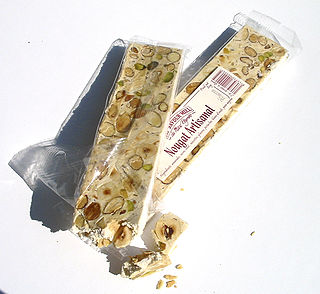
Nougat is a family of confections made with sugar or honey, roasted nuts, whipped egg whites, and sometimes chopped candied fruit. The consistency of nougat is chewy, and it is used in a variety of candy bars and chocolates. The word nougat comes from Occitan pan nogat, seemingly from Latin panis nucatus 'nut bread'.
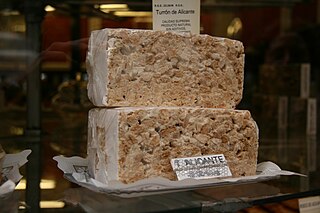
Turrón, or torrone, is a southwestern European nougat confection. In Spain it is reported that Arabics introduced desserts like this one but also Greeks and Romans travelled with these kind of food along the Mediterranean Sea, typically made of honey, sugar, and egg white, with toasted almonds or other nuts, and usually shaped into either a rectangular tablet or a round cake. It is frequently consumed as a traditional Christmas dessert in Spain, Portugal, and Italy as well as countries formerly under the Spanish Empire and Portuguese Empire, particularly in Latin America.

The Hotchkiss gun can refer to different products of the Hotchkiss arms company starting in the late 19th century. It usually refers to the 1.65-inch (42 mm) light mountain gun; there were also a navy (47 mm) and a 3-inch (76 mm) Hotchkiss guns. The 42 mm gun was intended to be mounted on a light carriage or packed on two mules to accompany a troop of cavalry or an army travelling in rough country.
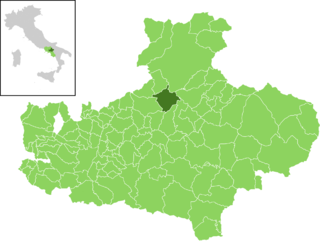
Grottaminarda is a town and comune in the province of Avellino (Campania), situated 80 kilometres (50 mi) northeast of Naples, in the southwest of Italy.

The 3.7 cm Flak 18/36/37 was a series of anti-aircraft guns produced by Nazi Germany that saw widespread service in the Second World War. The cannon was fully automatic and effective against aircraft flying at altitudes up to 4,200 m. The cannon was produced in both towed and self-propelled versions. Having a flexible doctrine, the Germans used their anti-aircraft pieces in ground support roles as well; 37 mm caliber guns were no exception to that. With Germany's defeat, production ceased and, overall, 37 mm caliber anti-aircraft cannon fell into gradual disuse, being replaced by the Bofors 40 mm gun and later, by 35-mm anti-aircraft pieces produced in Switzerland.
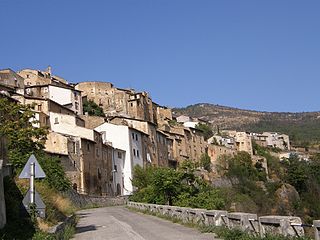
Acciano is a comune in the Province of L'Aquila in the Abruzzo region of Italy. The small, medieval village is in the Subequana valley and is a part of the Sirentina Mountain Community.

San Marco dei Cavoti is a comune (municipality) in the Province of Benevento in the Italian region Campania, located near the Fortore River valley.

Bagnara Calabra is a comune (municipality) in the Province of Reggio Calabria in Calabria, southern Italy. It is located in the hills facing the Tyrrhenian Sea on the southern tip of the region, about 100 kilometres (62 mi) southwest of Catanzaro and about 25 kilometres (16 mi) northeast of Reggio Calabria.

Lago di Luzzone is a reservoir in Ticino, Switzerland. The reservoir has a volume of 108 million m³ and a surface area of 1.27 km2 (0.49 sq mi). It is located in the upper Blenio valley, in the municipalities of Ghirone and Aquila.

The 37 mm gun M1 was an anti-aircraft autocannon developed in the United States. It was used by the US Army in World War II.

The Torent Alto is a mountain of the Swiss Lepontine Alps, located on the border between the cantons of Ticino and Graubünden. It is the highest mountain lying on the chain between Pass Giümella, east of Biasca and Bellinzona.

The Cima di Rosso is a mountain in the Bregaglia Range of the Alps, located on the border between Italy and Switzerland. It lies between the valleys of Bregaglia and Malenco. On the western side of the mountain is the Forno Glacier.

The Sosto is a mountain of the Swiss Lepontine Alps, overlooking Olivone in the canton of Ticino. It lies south of the lake of Luzzone and west of the Torrone di Nav.
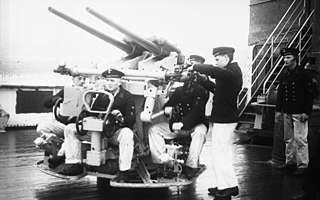
The 3.7 cm SK C/30 was the German Kriegsmarine's primary 3.7 cm (1.5 in) anti-aircraft gun during the Second World War. It was superseded by the fully automatic 3.7 cm FlaK 43 late in the war.
Anthony Torrone is an American Christian author who has a developmental disability. Torrone's 2011 book, Anthony's Prayers, was inspired by his time and the abuse that he experienced as a resident of the former Willowbrook State School, a New York State mental hospital for children. Torrone has been a resident of Grand Rapids, Michigan since the 1970s.
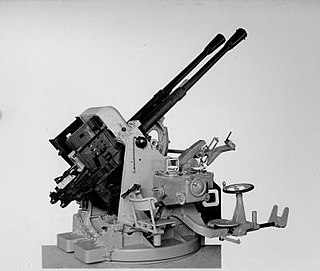
The Cannone-Mitragliera da 37/54 (Breda) was a 37 mm (1.5 in) automatic anti-aircraft gun produced by the Breda company in Italy.
The 13.2 mm Breda Model 31 was a widely used Italian heavy machine gun produced by Società Italiana Ernesto Breda and used by the Italian Navy and Italian Army during World War II. At sea it was employed as a light anti-aircraft gun, while on land it was mounted on armored command vehicles where it was used as a heavy machine gun. After World War II it remained in use aboard the patrol boats of the Guardia di Finanza.

The Canon de 37 mm Modèle 1925 was a widely used family of French anti-aircraft guns used by the French Navy during World War II.

Cupeta or copeta is a dessert made from honey, dissolved sugar and diced almonds.


















